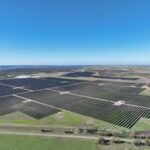Interactive map breaks down Texas renewable energy development by congressional district
 Wind power, solar power and energy storage projects are providing new economic opportunities for rural Texas counties, bringing needed diversification, economic development, job creation and multi-generational revenue through a growing property tax base and payments to landowners.
Wind power, solar power and energy storage projects are providing new economic opportunities for rural Texas counties, bringing needed diversification, economic development, job creation and multi-generational revenue through a growing property tax base and payments to landowners.
That’s the key takeaway of CleanPowerPays.org, a new interactive website launched this week by the Advanced Power Alliance (APA) and Solar Energy Industries Association (SEIA).
The interactive website breaks down — by Texas county, legislative district and congressional district — existing and planned wind, solar and storage capacity, estimated lifetime tax payments from those projects, and estimated lifetime landowner payments that individual Texans will receive from them.
The site shows that the overwhelming benefits of these investments flow to rural areas of the state. This helps to improve local schools, provide revenue for services and infrastructure and empower farmers and ranchers with new ways to generate income from their land.
The interactive tool reveals the massive investment in Texas, totaling more than $60 billion. Unsurprisingly, West Texas and Panhandle legislative districts dominate the wind energy space, with some districts receiving billions in new tax revenue. Districts in South Texas, and those spanning the length of the state north and south of the Dallas-Fort Worth Metroplex, also have seen significant tax revenue growth from both wind and solar projects.
This growth has provided a lifeline for rural landowners in recent years, and many farmers and ranchers rely on income from their renewable energy harvest to support their agricultural operations, especially during times of drought or low commodity prices.
As one example, landowners in the district of state Senator Brian Birdwell (R-Waco), Chairman of the Senate Natural Resources and Economic Development Committee, are on tap to receive $245 million dollars in lifetime payments for wind and solar projects being developed in that district, and local governments will receive an additional $199 million in tax revenue. Committee Vice-Chair Senator Judith Zaffirini from Laredo could see $1 billion tax revenue and $1.4 billion in landowner payments from wind and solar in her district. The district of a fellow committee member, Senator Kel Seliger, leads the committee in investment, thanks to the development of 6,579 MW of wind and 853 MW of solar already built in his Panhandle district. After planned projects are completed, Sen. Seliger’s district could see $1.8 billion in tax revenue and $1.9 billion in landowner payments from wind and solar.
Two bills, SB 1255 and SB 1256, will be heard in a Senate Natural Resources and Economic Development Committee hearing on Thursday. These bills would unfortunately remove wind and solar projects from the Chapters 312 and Chapter 313 programs, key Texas economic development initiatives that have helped provide economic growth and additional school funding to long-neglected rural communities. In addition to harming future revenue streams for rural Texas, the bills will raise electricity prices on all Texas consumers.
“The CleanPowerPays.org website shows the incredible financial benefits that solar and wind energy have created in Texas, and we’re proud to offer this tool so the public can see not only where their renewable power comes from, but also how that investment is affecting Texas communities. Texas must continue to lead in every form of energy, and this site visually demonstrates how the continued growth of our energy economy can pay dividends for rural Texas,” said Jeff Clark, president of the Advanced Power Alliance. “This is not the time to abdicate our energy leadership. Programs like Chapter 312 and Chapter 313 work to grow our economy. Texans need leaders to strengthen them, not undermine growth by eliminating proven economic development tools.”
“Rural Texas can greatly benefit from solar, and this new tool will show lawmakers just how much large solar projects can contribute to rural communities,” said Nakhia Crossley, central region director and counsel at the Solar Energy Industries Association. “This interactive map shows how numerous communities across Texas are already benefiting from solar, and how much money these projects are contributing to local tax revenues and payments to landowners. As we look to grow the solar industry in Texas, this tool will help us better understand the economic growth potential of solar.”
News item from the Advanced Power Alliance
<!–
–>
Original Source: https://www.solarpowerworldonline.com/2021/03/interactive-map-seia-apa-texas-renewable-energy/












